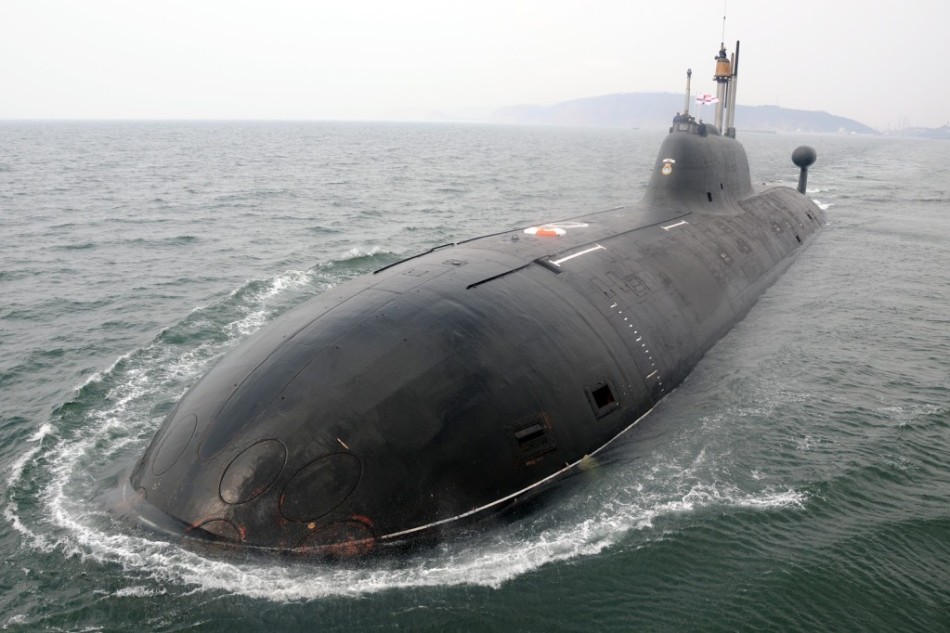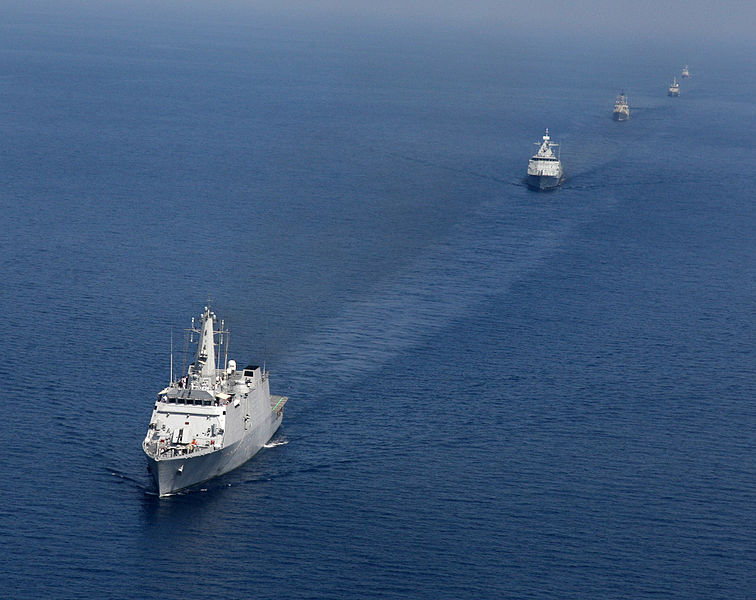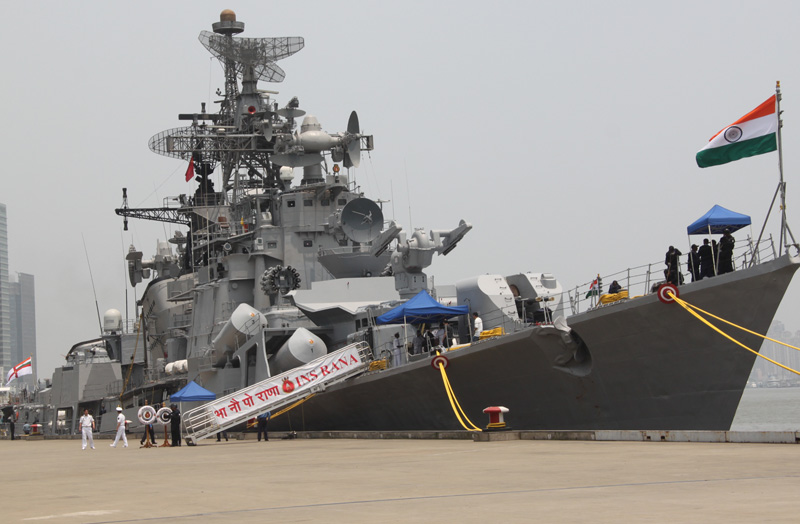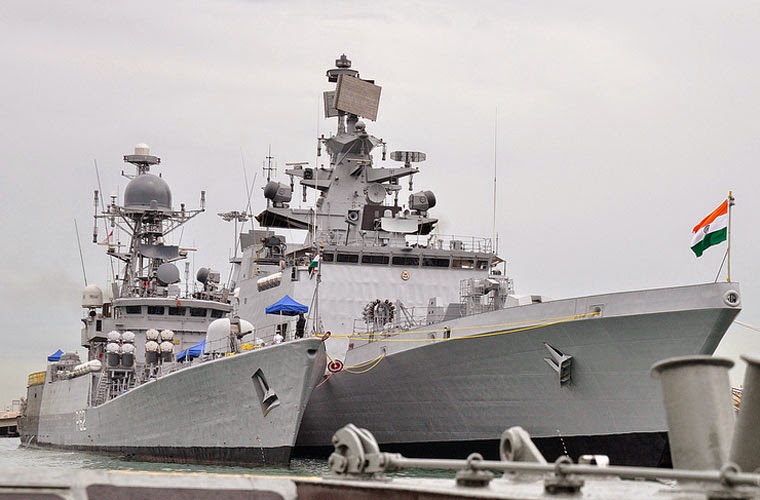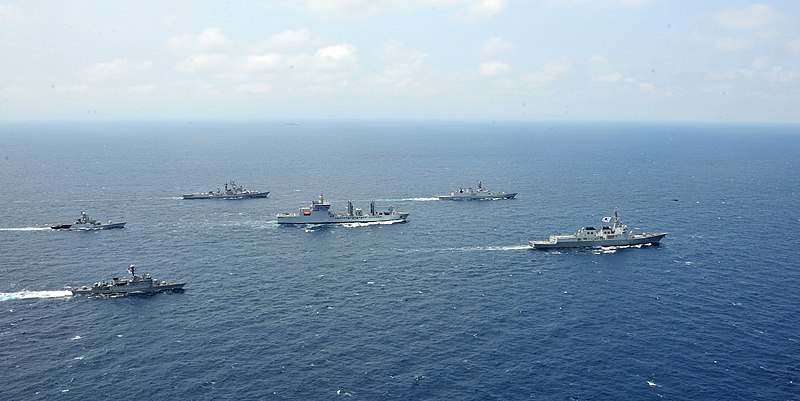Major Shaitan Singh
SENIOR MEMBER

- Joined
- Dec 7, 2010
- Messages
- 3,550
- Reaction score
- 43
- Country
- Location
The Indian Ocean is fast turning into one of the busiest oceans in the world. Most of the world’s oil supply passes through this region which makes secure sea lines very vital. Who will play a major role in the Indian Ocean is often a topic of debate. India has a large responsibility in the region, being a powerful and democratic nation with peaceful ambitions. The US has a military presence in the form of its base, Diego Garcia. However, China has been repeatedly making forays into this region of late, to showcase its naval reach and project power. This has turned the Indian Ocean into a playground for powerful navies.
Australian researcher Lindsay Hughes, who is now a contributing guest author for Defencyclopedia, analyses the role and growth of Indian and Chinese navies. This is 4-part series will document the historical, geographical, economic and military reasons reaponsible for the military buildup and this article is the first one in the series.
Summary
To protect their growing economies, China and India have securitised their sea-borne trade routes by enhancing their naval prowess, which act enhances their seapower. This enhancement, however, causes each other concern by making each suspicious of the other’s intention. Thus, they further strengthen their navies, leading to a cycle of enhanced naval power and growing suspicion.
For strategic reasons – sometimes referred to as the logic of their growth – China and India deploy – or plan to deploy – their navies near each other’s maritime borders. China is creating strategic relationships with littoral states in the Indian Ocean Region (IOR) and India does likewise, with the same states and others in the East and South China Seas. This leads each to further debate the other’s intentions to understand how those may impact upon their own interests. What remains unclear to the independent observer, however, is whether the intention of both countries in developing their navies is defensive or if each has an underlying agenda for its naval enhancement.
India has adopted a policy of upgrading its naval capacity since the 1980s.Given China’s growing presence in the IOR and its long-standing power competition with India, this section will consider whether India’s on-going naval modernisation aims to achieve an active force posture driven by its strategic intent to have secure open-ocean access or if China’s growing naval ambitions compel New Delhi to respond. It will do this by examining India’s naval growth, its force posture and its maritime policy in relation to extending its influence in South-East and East Asia.
This study, therefore, will examine the reasons for the enhancement of Chinese and Indian naval capability, to determine if these are benign or otherwise.
ANALYSIS
INDIA’S NAVAL MODERNISATION
Between 1980 and 2009, however, the Indian Navy progressed from being a “brown-water” to almost a “blue-water” force; i.e. from one relatively bound to a land base to one almost capable of projecting power at considerable distances from its bases. In 1980 the Indian Navy’s core comprised of ten Soviet-origin Petya-class frigates, two Whitby-class frigates, five Leander-class frigates, and three Nanuchka-class corvettes. In total, there were twenty three major warships, including one aging aircraft carrier.
Unsurprisingly, when during the so-called “Tanker War” period of the Iran-Iraq War of 1980 – 1997 the largest number of tankers to be hit in the Persian Gulf were Indian, the Indian Navy did not deploy, leave alone take action to protect them. While government policy may have been responsible to some extent for this lack of action, the fact that long-range ships were so scarce as to make any retaliatory action impossible provides a better reason.

Leander ‘Nilgiri’ class frigate

The old INS Vikrant was decomissioned in 1997
By 2010, however, these older ships had been decommissioned. In their place are one more modern aircraft carrier, fourteen operational submarines and 34 major war ships. There are also eight world-class hydrography vessels, which have completed several major oceanographic surveys in the Indian and Western Pacific Oceans for the Indian Navy. However, the planned 140-ship navy is still a far way off, since various Indian governments have allocated more of the defence budget to the air force and army. Nonetheless, the modernisation of the Indian Navy has advanced considerably.
By 2013, ninety five per cent of India’s foreign trade by volume and seventy five per cent by value was conducted by sea; also, more than seventy per cent of its oil was imported by sea. With India’s economic growth, its navy has grown in importance. This growth may be measured by three parameters: the number of ships, their size and the number of missile batteries per ship. The following Table gives an indication of the Indian navy’s growth.
Indian Navy in 1991 – 2012

The Indian Navy has remained more or less static in the number of its ships. It is the number of ship-borne missile cells available today that indicate its modernisation. This begs the question, why is India modernising its navy? Does it, like China, seek regional hegemony? Does it conform to Mahan’s theory of sea power and Mearsheimer’s offensive-realism? These questions are best answered by examining its process of modernisation, the types of vessels being built and acquired, and its maritime strategy.
Missiles first made their appearance in the Indian Navy in 1971 during the Indo-Pakistani War, when they were used in Operations Trident and Python to effectively neutralise the Pakistani Navy in Karachi for the term of the war. This success led the Indian Navy to convert the main armament of their ships to missiles. More recently, the Shivalik and Talwar-class ships have been fitted with modern Klub(Russian Novator KH-54 TE) active radar-homing missiles as well as the Russo-Indian supersonic Brahmos missiles. The Klubs have been replaced by the Brahmos missiles on the very latest Talwar-class ships being built in Russia. However, missiles are a standard part of a ship’s armament today and can be offensive or defensive in nature, making it is difficult to gauge India’s strategic maritime intent from their numbers alone; other facets of the Indian Navy’s modernisation must be examined to reach a reasonable conclusion.
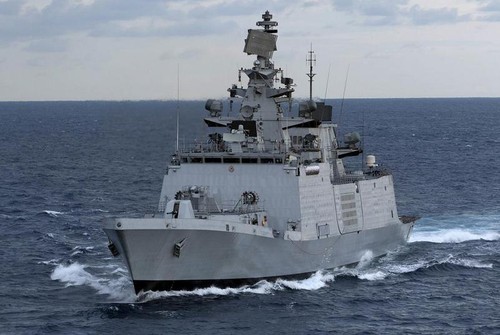
Shivalik class

INS Vikramaditya
Building an aircraft carrier is one of the biggest and most complex tasks of any navy. India planned to build a twenty thousand ton carrier, but its tonnage was soon expanded to forty thousand. Additionally, the Indian Navy has purchased the refitted Russian aircraft carrier, the Admiral Gorshkov, as its second carrier. A third carrier, designed to accommodate thirty fighter aircraft, is being built at the Kochi Shipyard in Kerala, India.
Aircraft carriers are the most conspicuous symbol of a nation’s ability to project maritime power. They carry fighter aircraft, primarily to take the battle to an enemy and move it away from the homeland. As such, they are offensive by their very nature. The Indian Navy plans to operate three carriers by 2017.
This demonstrates India’s desire to be acknowledged as a maritime power and, more broadly, a rising world power. To an extent, it also demonstrates India’s aspirations towards projecting its power over distances, which could demonstrate aspirations towards regional hegemony. However, while the general contours of a move towards regional hegemony are discernible, further examination is needed to determine if this is the case.
India’s ship-building industry is no match for China’s. Nevertheless, it is a collaboration between shipyards, ship designers, technical specialists, equipment suppliers and an arm of the Indian Navy called the Weapons Electronics System Engineering Establishment (WESEE). This body was established to ensure the compatibility between Russian-supplied missiles and Western electronics systems. The Indian Navy also has engineers at Mazagaon Docks in Mumbai, where theGodavari-class ships were designed and built from 1983, and the previously-noted facility at Kochi.
There is an obvious mismatch between China’s and India’s ship-building capacities. Since ship-building is an important facet of seapower, the question must be asked: does this mean India has no aspirations to regional hegemony? Up to this point, this study shows that the Indian Navy has not increased in size but has been modernised, it has plans to obtain three aircraft carriers, and it has a comparatively minor ship-building industry. These observations produce conflicting signals, making it difficult to determine if India has regional naval aspirations. This study must examine its maritime doctrine to make a determination.

Official Indian Navy CGI of the new INS Vikrant
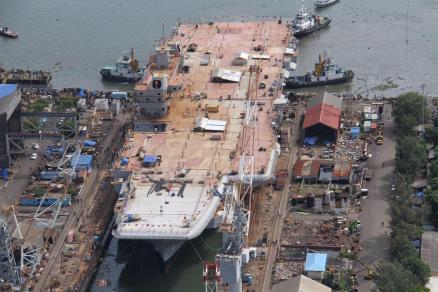
The new INS Vikrant will be ready by 2018
Australian researcher Lindsay Hughes, who is now a contributing guest author for Defencyclopedia, analyses the role and growth of Indian and Chinese navies. This is 4-part series will document the historical, geographical, economic and military reasons reaponsible for the military buildup and this article is the first one in the series.
Summary
To protect their growing economies, China and India have securitised their sea-borne trade routes by enhancing their naval prowess, which act enhances their seapower. This enhancement, however, causes each other concern by making each suspicious of the other’s intention. Thus, they further strengthen their navies, leading to a cycle of enhanced naval power and growing suspicion.
For strategic reasons – sometimes referred to as the logic of their growth – China and India deploy – or plan to deploy – their navies near each other’s maritime borders. China is creating strategic relationships with littoral states in the Indian Ocean Region (IOR) and India does likewise, with the same states and others in the East and South China Seas. This leads each to further debate the other’s intentions to understand how those may impact upon their own interests. What remains unclear to the independent observer, however, is whether the intention of both countries in developing their navies is defensive or if each has an underlying agenda for its naval enhancement.
India has adopted a policy of upgrading its naval capacity since the 1980s.Given China’s growing presence in the IOR and its long-standing power competition with India, this section will consider whether India’s on-going naval modernisation aims to achieve an active force posture driven by its strategic intent to have secure open-ocean access or if China’s growing naval ambitions compel New Delhi to respond. It will do this by examining India’s naval growth, its force posture and its maritime policy in relation to extending its influence in South-East and East Asia.
This study, therefore, will examine the reasons for the enhancement of Chinese and Indian naval capability, to determine if these are benign or otherwise.
ANALYSIS
INDIA’S NAVAL MODERNISATION
Between 1980 and 2009, however, the Indian Navy progressed from being a “brown-water” to almost a “blue-water” force; i.e. from one relatively bound to a land base to one almost capable of projecting power at considerable distances from its bases. In 1980 the Indian Navy’s core comprised of ten Soviet-origin Petya-class frigates, two Whitby-class frigates, five Leander-class frigates, and three Nanuchka-class corvettes. In total, there were twenty three major warships, including one aging aircraft carrier.
Unsurprisingly, when during the so-called “Tanker War” period of the Iran-Iraq War of 1980 – 1997 the largest number of tankers to be hit in the Persian Gulf were Indian, the Indian Navy did not deploy, leave alone take action to protect them. While government policy may have been responsible to some extent for this lack of action, the fact that long-range ships were so scarce as to make any retaliatory action impossible provides a better reason.

Leander ‘Nilgiri’ class frigate

The old INS Vikrant was decomissioned in 1997
By 2010, however, these older ships had been decommissioned. In their place are one more modern aircraft carrier, fourteen operational submarines and 34 major war ships. There are also eight world-class hydrography vessels, which have completed several major oceanographic surveys in the Indian and Western Pacific Oceans for the Indian Navy. However, the planned 140-ship navy is still a far way off, since various Indian governments have allocated more of the defence budget to the air force and army. Nonetheless, the modernisation of the Indian Navy has advanced considerably.
By 2013, ninety five per cent of India’s foreign trade by volume and seventy five per cent by value was conducted by sea; also, more than seventy per cent of its oil was imported by sea. With India’s economic growth, its navy has grown in importance. This growth may be measured by three parameters: the number of ships, their size and the number of missile batteries per ship. The following Table gives an indication of the Indian navy’s growth.
Indian Navy in 1991 – 2012
The Indian Navy has remained more or less static in the number of its ships. It is the number of ship-borne missile cells available today that indicate its modernisation. This begs the question, why is India modernising its navy? Does it, like China, seek regional hegemony? Does it conform to Mahan’s theory of sea power and Mearsheimer’s offensive-realism? These questions are best answered by examining its process of modernisation, the types of vessels being built and acquired, and its maritime strategy.
Missiles first made their appearance in the Indian Navy in 1971 during the Indo-Pakistani War, when they were used in Operations Trident and Python to effectively neutralise the Pakistani Navy in Karachi for the term of the war. This success led the Indian Navy to convert the main armament of their ships to missiles. More recently, the Shivalik and Talwar-class ships have been fitted with modern Klub(Russian Novator KH-54 TE) active radar-homing missiles as well as the Russo-Indian supersonic Brahmos missiles. The Klubs have been replaced by the Brahmos missiles on the very latest Talwar-class ships being built in Russia. However, missiles are a standard part of a ship’s armament today and can be offensive or defensive in nature, making it is difficult to gauge India’s strategic maritime intent from their numbers alone; other facets of the Indian Navy’s modernisation must be examined to reach a reasonable conclusion.

Shivalik class

INS Vikramaditya
Building an aircraft carrier is one of the biggest and most complex tasks of any navy. India planned to build a twenty thousand ton carrier, but its tonnage was soon expanded to forty thousand. Additionally, the Indian Navy has purchased the refitted Russian aircraft carrier, the Admiral Gorshkov, as its second carrier. A third carrier, designed to accommodate thirty fighter aircraft, is being built at the Kochi Shipyard in Kerala, India.
Aircraft carriers are the most conspicuous symbol of a nation’s ability to project maritime power. They carry fighter aircraft, primarily to take the battle to an enemy and move it away from the homeland. As such, they are offensive by their very nature. The Indian Navy plans to operate three carriers by 2017.
This demonstrates India’s desire to be acknowledged as a maritime power and, more broadly, a rising world power. To an extent, it also demonstrates India’s aspirations towards projecting its power over distances, which could demonstrate aspirations towards regional hegemony. However, while the general contours of a move towards regional hegemony are discernible, further examination is needed to determine if this is the case.
India’s ship-building industry is no match for China’s. Nevertheless, it is a collaboration between shipyards, ship designers, technical specialists, equipment suppliers and an arm of the Indian Navy called the Weapons Electronics System Engineering Establishment (WESEE). This body was established to ensure the compatibility between Russian-supplied missiles and Western electronics systems. The Indian Navy also has engineers at Mazagaon Docks in Mumbai, where theGodavari-class ships were designed and built from 1983, and the previously-noted facility at Kochi.
There is an obvious mismatch between China’s and India’s ship-building capacities. Since ship-building is an important facet of seapower, the question must be asked: does this mean India has no aspirations to regional hegemony? Up to this point, this study shows that the Indian Navy has not increased in size but has been modernised, it has plans to obtain three aircraft carriers, and it has a comparatively minor ship-building industry. These observations produce conflicting signals, making it difficult to determine if India has regional naval aspirations. This study must examine its maritime doctrine to make a determination.

Official Indian Navy CGI of the new INS Vikrant

The new INS Vikrant will be ready by 2018

